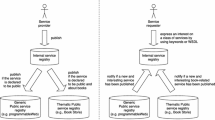Abstract
During the past three years, the Web has undergone a radical change towards a highly user-centred cyberspace where end users can easily participate and collaborate for their own benefits and profits. The surge of Web services has created increasingly demand by end users and small-and-medium enterprises to effectively participate in service publication, discovery, and subscription over the Web. However, current public service discovery mechanism, one of the key aspects in the SOA, does not align itself with this fully user-oriented Web. The recent shutdown of public UDDI exposes issues and makes public Web services discovery missing. In this paper, we propose a novel Web service discovery architecture—AtomServ, which is built upon widely adopted Web2.0 technology (RSS/Atom) and the publish/subscribe model. It aims to provide a handy and scalable discovery facility for most Web services providers and requesters, who can easily participate in service discovery via various user-friendly application interfaces (e.g., web browsers, mobile phones). With the proliferation of RSS/Atom, AtomServ widens the adoption of service discovery by allowing simple and unified user access to frequently changing business services. This undoubtedly lowers the entry barrier for end users to play their roles in a user-centred Service-Oriented Web environment.
Similar content being viewed by others
References
Baresi L, and Miraz M (2006) A distributed approach for the federation of heterogeneous registries. Presented at 4th International Conference on Service Oriented Computing, Chicago, USA
Ogbuji U (2005) UDDI 3.0? Who really cares? Oreilly
Chappell D (2002). Who cares about UDDI. Addison Wesley, New York
Musser J, O’Reilly T (2006) Web 2.0 Principles and Best Practices: O’REILLY RADAR
Nottingham M, Sayre R (2005) The atom syndication format. In RFC 4287: The Internet Society
RSS2.0 Specification (2005) http://www.rssboard.org/rss- specification
Gregorio J, de hOra B (2007) The atom publishing protocol
Fielding RT (2000) Architectural styles and the design of network-based software architectures. PhD Dissertations, University of California, Irvine, CA, USA
Bosworth A (2005) Learning from THE WEB. ACM QUEUE, vol. October, pp 26–32
Williamson DW, Stanger NJ (2005) A lightweight data integration architecture using atom. Presented at WebDB, MD, USA
Ozzie J, Moromisato G, Suthar P (2006) Simple sharing extensions for RSS and OPML. In: Microsoft MSDN: Microsoft Corporation
Clinton D (2006) Open Search Specification 1.1 Draft 3. http:// www.opensearch.org/
Snell J (2005) Advertise Web services with Atom 1.0. In IBM developerWorks. http://www128.ibm.com/developerworks/webservices/library/ws-atomwas.
Box D, Curbera F (2004) Web Services Addressing (WS-Addressing). http://www.w3.org/Submission/ws-addressing/
Ballinger K, Brittenham P, Malhotra A, Nagy WA, Pharies S (2001) Web Services inspection language (WS-Inspection) 1.0, vol 2006
Graham S, Niblett P (2004) Web Services Topics. ftp://www6. software.ibm.com / software / developer / library/ws-notification / WSTopics.pdf
Fielding RT, Gettys J, Mogual J, Frystyk H, Masinter L, Leach P, Berners-Lee T (1999) RFC 2616—hypertext transfer protocol—HTTP/1.1. The Internet Society
Mogual J, Krishnamurthy B, Douglis F, Feldmann A, Goland Y, Hoff AV, Hellerstein D (2002) RFC3229—Delta encoding in HTTP. The Internet Society
RFC 3329 (2002) Delta encoding in HTTP
Berry MW, Drmac Z and Jessup ER (1999). Matrices, vector spaces, and information retrieval. SIAM Rev 41: 335–362
Baeza-Yates R and Ribeiro-Neto B (1999). Modern information retrieval. Addison Wesley, New York
Deerwester S, Dumais S, Furnas GW, Landauer TK and Harshamn R (1990). Indexing by latent semantic analysis. J Am Soc Inf Sci 41: 391–407
Bomhoff M, Huibers T, Vet Pvd (2005) User intentions in information retrieval, presented at 5th Dutch Beligion workshop in information retrieval
Perry DE and Wolf AL (1992). Foundations for the study of software architecture. ACM SIGSOFT Softw Eng Notes 17: 40–52
Eugster PT, Felber PA, Guerraoui R and Kermarrec A-M (2003). The many faces of publish/subscribe. ACM Surv 35: 114–131
Author information
Authors and Affiliations
Corresponding author
Rights and permissions
About this article
Cite this article
Wu, C., Chang, E. Aligning with the Web: an atom-based architecture for Web services discovery. SOCA 1, 97–116 (2007). https://doi.org/10.1007/s11761-007-0008-x
Received:
Revised:
Accepted:
Published:
Issue Date:
DOI: https://doi.org/10.1007/s11761-007-0008-x




